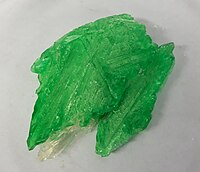
Photo from wikipedia
Gaseous potassium (K) species play an important role in biomass combustion processes, and imaging techniques are powerful tools to investigate the related gas-phase chemistry. Here, laser absorption imaging of gaseous… Click to show full abstract
Gaseous potassium (K) species play an important role in biomass combustion processes, and imaging techniques are powerful tools to investigate the related gas-phase chemistry. Here, laser absorption imaging of gaseous atomic K in flames is implemented using tunable diode laser absorption spectroscopy at 769.9 nm and a high-speed complementary metal oxide semiconductor (CMOS) camera recording at 30 kfps. Atomic K absorption spectra are acquired for each camera pixel in a field of view of 28 × 28 mm at a rate of 100 Hz. The technique is used to determine the spatial distribution of atomic K concentration during the conversion of potassium chloride (KCl) salt and wheat straw particles in a laminar premixed CH4/air flame with an image pixel resolution of up to 120 μm. Due to axisymmetry in setup geometry and, consequently, atomic K distributions, the radial atomic K concentration fields could be reconstructed by one-dimensional tomography. For the KCl sample, the K concentration field was in excellent agreement with previous point measurements. In the case of wheat straw, atomic K concentrations of around 3 ppm were observed in a cylindrical flame during devolatilization. In the char conversion phase, a spherical layer of atomic K, with concentrations reaching 25 ppm, was found within 5 mm of the particle surface, while the concentration rapidly decreased to sub-ppm levels along the vertical axis. In both cases, a thin (∼1 mm) layer without any atomic K was observed in close vicinity to the particle, suggesting that the potassium was initially not released in its atomic form.
Journal Title: Analytical Chemistry
Year Published: 2022
Link to full text (if available)
Share on Social Media: Sign Up to like & get
recommendations!